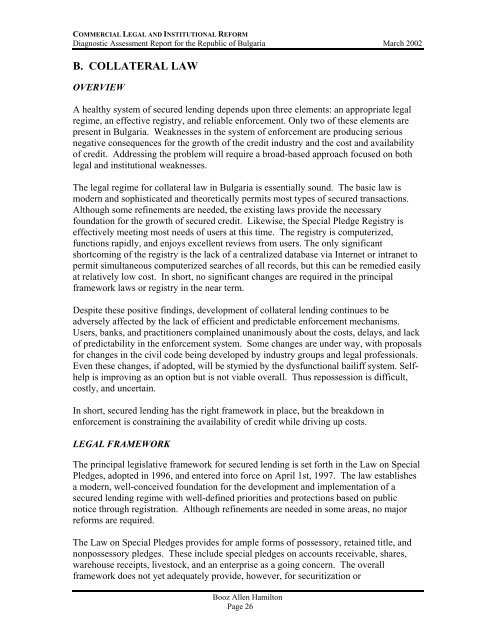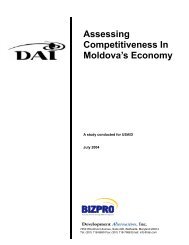Commercial Legal And Institutional Reform (CLIR) - Economic Growth
Commercial Legal And Institutional Reform (CLIR) - Economic Growth
Commercial Legal And Institutional Reform (CLIR) - Economic Growth
You also want an ePaper? Increase the reach of your titles
YUMPU automatically turns print PDFs into web optimized ePapers that Google loves.
COMMERCIAL LEGAL AND INSTITUTIONAL REFORM<br />
Diagnostic Assessment Report for the Republic of Bulgaria March 2002<br />
B. COLLATERAL LAW<br />
OVERVIEW<br />
A healthy system of secured lending depends upon three elements: an appropriate legal<br />
regime, an effective registry, and reliable enforcement. Only two of these elements are<br />
present in Bulgaria. Weaknesses in the system of enforcement are producing serious<br />
negative consequences for the growth of the credit industry and the cost and availability<br />
of credit. Addressing the problem will require a broad-based approach focused on both<br />
legal and institutional weaknesses.<br />
The legal regime for collateral law in Bulgaria is essentially sound. The basic law is<br />
modern and sophisticated and theoretically permits most types of secured transactions.<br />
Although some refinements are needed, the existing laws provide the necessary<br />
foundation for the growth of secured credit. Likewise, the Special Pledge Registry is<br />
effectively meeting most needs of users at this time. The registry is computerized,<br />
functions rapidly, and enjoys excellent reviews from users. The only significant<br />
shortcoming of the registry is the lack of a centralized database via Internet or intranet to<br />
permit simultaneous computerized searches of all records, but this can be remedied easily<br />
at relatively low cost. In short, no significant changes are required in the principal<br />
framework laws or registry in the near term.<br />
Despite these positive findings, development of collateral lending continues to be<br />
adversely affected by the lack of efficient and predictable enforcement mechanisms.<br />
Users, banks, and practitioners complained unanimously about the costs, delays, and lack<br />
of predictability in the enforcement system. Some changes are under way, with proposals<br />
for changes in the civil code being developed by industry groups and legal professionals.<br />
Even these changes, if adopted, will be stymied by the dysfunctional bailiff system. Selfhelp<br />
is improving as an option but is not viable overall. Thus repossession is difficult,<br />
costly, and uncertain.<br />
In short, secured lending has the right framework in place, but the breakdown in<br />
enforcement is constraining the availability of credit while driving up costs.<br />
LEGAL FRAMEWORK<br />
The principal legislative framework for secured lending is set forth in the Law on Special<br />
Pledges, adopted in 1996, and entered into force on April 1st, 1997. The law establishes<br />
a modern, well-conceived foundation for the development and implementation of a<br />
secured lending regime with well-defined priorities and protections based on public<br />
notice through registration. Although refinements are needed in some areas, no major<br />
reforms are required.<br />
The Law on Special Pledges provides for ample forms of possessory, retained title, and<br />
nonpossessory pledges. These include special pledges on accounts receivable, shares,<br />
warehouse receipts, livestock, and an enterprise as a going concern. The overall<br />
framework does not yet adequately provide, however, for securitization or<br />
Booz Allen Hamilton<br />
Page 26

















